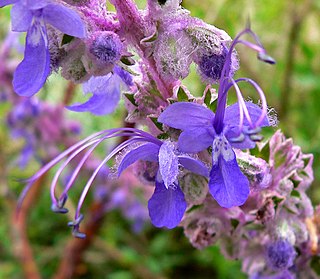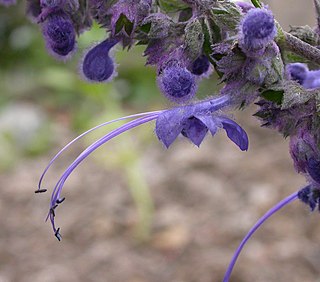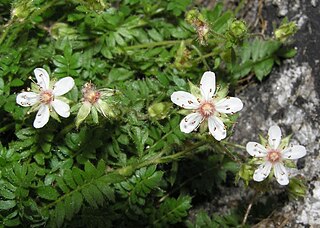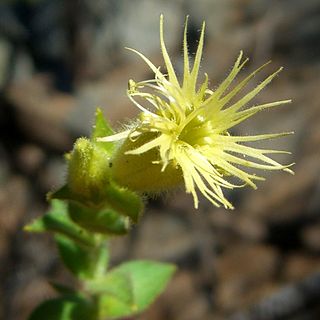
The Santa Rosa and San Jacinto Mountains National Monument is a National Monument in southern California. It includes portions of the Santa Rosa and San Jacinto mountain ranges, the northernmost ones of the Peninsular Ranges system. The national monument covers portions of Riverside County, west of the Coachella Valley, approximately 100 miles (160 km) southeast of downtown Los Angeles.

Trichostema lanatum, the woolly bluecurls, is a small evergreen shrub or sub-shrub native to arid coastal chaparral regions of California and the northern parts of Baja California.

Trichostema is a genus of flowering plants in the family Lamiaceae, which are aromatic herbs or subshrubs. These plants are native to North America. Many plant of this genus which have whorls of small blue flowers are called by the common name bluecurls.

Ivesia callida is a rare species of flowering plant in the rose family known by the common name Tahquitz mousetail. It is endemic to the San Jacinto Mountains of Riverside County, California, where it is known from only two occurrences. The plant grows in cracks and crevices of the granite mountain cliffs. It was named for Tahquitz, a rock formation in its endemic range. This is a small perennial herb which forms matted patches of hanging foliage on cliff faces. The leaves are strips of oval-shaped green leaflets. Each leaf is up to 7 centimeters long and has several pairs of hairy, glandular leaflets. The thin, green, hanging stems are up to 15 centimeters long and bears an inflorescence of several flowers. Each flower has five hairy, pointed sepals and five rounded to oval white petals. The center of the flower contains twenty stamens with disc-shaped anthers and several pistils.

Saltugilia splendens is a species of flowering plant in the phlox family known by the common names splendid woodland-gilia, Grinnell's gilia and splendid gilia.

Trichostema dichotomum, common name forked bluecurls, is a flowering plant in the mint family (Lamiaceae). The plant is found in the Midwestern and Eastern United States, Eastern Canada, and the Bahamas.
Astragalus leucolobus is a species of milkvetch known by the common names Bear Valley milkvetch and Bear Valley woollypod.
Monardella australis is a species of flowering plant in the mint family, known by the common name southern monardella.

Silene parishii is a species of flowering plant in the family Caryophyllaceae known by the common name Parish's catchfly. It is endemic to southern California, where it is known from several of the local mountain ranges, including the San Bernardino, San Gabriel, and San Jacinto Mountains. It grows in rocky, forested habitat, sometimes in the alpine climates of the higher peaks. It is a perennial herb growing from a woody, branching caudex and taproot, sending up several decumbent or erect stems 10 to 40 centimetres tall. The oppositely arranged leaves line the stems, the largest ones located at the middle of each stem. Leaves are lance-shaped to nearly oval and up to 6 centimetres long. They are thick and leathery, and sometimes glandular and sticky. Each flower is encapsulated in a tubular calyx of fused sepals which may be nearly 3 centimetres long. It is greenish with ten veins and a coating of glandular hairs. The five petals are yellowish in colour and each has about six long, fringelike lobes at the tip.
Tauschia parishii is a species of flowering plant in the carrot family known by the common name Parish's umbrellawort. It is endemic to California.
Trichostema laxum is a species of flowering plant in the mint family, known by the common name turpentine weed from the foliage's scent.
Trichostema micranthum is a species of flowering plant in the mint family, known by the common name smallflower bluecurls.
Trichostema oblongum, known by the common names oblong bluecurls and mountain bluecurls, is a species of flowering plant in the mint family.

Trichostema ovatum is an uncommon species of flowering plant in the mint family known by the common name San Joaquin bluecurls.
Trichostema parishii is a species of flowering plant in the mint family known by the common name Parish's bluecurls.
Trichostema rubisepalum is a species of flowering plant in the mint family known by the common name Hernandez's bluecurls.
Trichostema ruygtii, with the common name Napa bluecurls, is a species of flowering plant in the mint family. It was first described to science in 2006.
Trichostema simulatum is a species of flowering plant in the mint family known by the common name Siskiyou bluecurls.
Trichostema arizonicum, the Arizona bluecurls, is a perennial plant in the mint family (Lamiaceae) native to the Southwestern United States and northwestern Mexico. It has striking curling flowers and can often be found along road sides. The genus name means "hair stems" in reference to the graceful stamens that curl around to dab pollen on the backs of insect pollinators.

Trichostema setaceum is an herbaceous flowering plant. Commonly referred to as narrowleaf bluecurls, it is in the Lamiaceae. It grows in sandy soil, sandhills, and rocky uplands.









